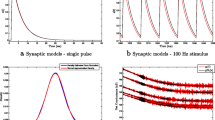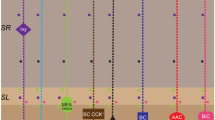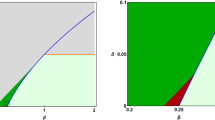Abstract
The hippocampus is a brain structure critical for memory functioning. Its network dynamics include several patterns such as sharp waves that are generated in the CA3 region. To understand how population outputs are generated, models need to consider aspects of network size, cellular and synaptic characteristics and context, which are necessarily ‘balanced’ in appropriate ways to produce particular outputs. Thick slice hippocampal preparations spontaneously produce sharp waves that are initiated in CA3 regions and depend on the right balance of glutamatergic activities. As a step toward developing network models that can explain important balances in the generation of hippocampal output, we develop models of CA3 pyramidal cells. Our models are single compartment in nature, use an Izhikevich-type structure and involve parameter values that are specifically designed to encompass CA3 intrinsic properties. Importantly, they incorporate spike frequency adaptation characteristics that are directly comparable to those measured experimentally. Excitatory networks using these model cells are able to produce bursting suggesting that the amount of spike frequency adaptation expressed in the biological cells is an essential contributor to network bursting, and as such, may be important for sharp wave generation. The network bursting mechanism is numerically dissected showing the critical balance between adaptation and excitatory drive. The compact nature of our models allows large network simulations to be efficiently computed. This, together with the linkage of our models to cellular characteristics, will allow us to develop an understanding of population output of CA3 hippocampus with direct biological comparisons.










Similar content being viewed by others
References
Andersen, P., Morris, R., Amaral, D., Bliss, T., & O’Keefe, J. (Eds.) (2006). The hippocampus book. Oxford: Oxford University Press.
Bianchi, R., Chuang, S. C., & Wong, R. K. (2006). Pharmacology of a slowly inactivating outward current in hippocampal CA3 pyramidal neurons. Journal of Neurophysiology, 96(3), 1116–1123.
Buzsaki, G. (1986). Hippocampal sharp waves: Their origin and significance. Brain Research, 398, 242–252.
Buzsaki, G. (2011). Hippocampus. Scholarpedia, 6(1), 1468.
De Almeida, L., Idiart, M., & Lisman, J. E. (2007). Memory retrieval time and memory capacity of the CA3 network: Role of gamma frequency oscillations. Learning and Memory, 14, 795–806.
Destexhe, A., Mainen, Z. F., & Sejnowski, T. J. (1998). Kinetic models of synaptic transmission. In C. Koch, & I. Segev (Eds.), Methods in neuronal modeling: From synapses to networks. Cambridge: MIT Press.
Freund, T. F., & Buzsaki, G. (1996). Interneurons of the hippocampus. Hippocampus, 6(4), 347–470.
Goutagny, R., Jackson, J., & Williams, S. (2009). Self-generated theta oscillations in the hippocampus. Nature Neuroscience, 12(12), 1491–1493.
Gu, N., Vervaeke, K., & Storm, J. F. (2007). BK potassium channels facilitate high-frequency firing and cause early spike frequency adaptation in rat CA1 hippocampal pyramidal cells. Journal of Physiology, 580, 859–882.
Hemond, P., Epstein, D., Boley, A., Migliore, M., Ascoli, G. A., & Jaffe, D. B. (2008). Distinct classes of pyramidal cells exhibit mutually exclusive firing patterns in hippocampal area CA3b. Hippocampus, 18, 411–424.
Hemond, P., Migliore, M., Ascoli, G. A., & Jaffe, D. B. (2009). The membrane response of hippocampal CA3b pyramidal neurons near rest: Heterogeneity of passive properties and the contribution of hyperpolarization-activated currents. Neuroscience, 160(2), 359–370.
Ho, E. C. Y. (2011). If you want to be slow you have to be fast: Control of slow population activities by fast-spiking interneurons via network multistability. PhD Thesis, University of Toronto.
Ho, E. C. Y., Zhang, L., & Skinner, F. K. (2009a). Inhibition dominates in shaping spontaneous CA3 hippocampal network activities in vitro. Hippocampus, 19(2), 152–165.
Ho, E., Zhang, L., & Skinner, F. K. (2009b). Mathematical analyses and simulations predict conditions for the emergence of slow population rhythms. Program no. 321.16. In 2009 Neuroscience meeting planner. Chicago: Society for Neuroscience. Online.
Izhikevich, E. M. (2003). Simple model of spiking neurons. IEEE Transactions on Neural Networks, 14, 1569–1572.
Izhikevich, E. M. (2007). Dynamical systems in neuroscience. Cambridge: MIT Press.
Latham, P. E., Richmond, B. J., Nelson, P. G., & Nirenberg, S. (2000). Intrinsic dynamics in neuronal networks. I. Theory. Journal of Neurophysiology, 83(2), 808–827.
Li, X. G., Somogyi, P., Ylinen, A., & Buzsaki, G. (1994). The hippocampal CA3 network: An in vivo intracellular labeling study. Journal of Comparative Neurology, 339(2), 181–208.
Lisman, J. E. (1997). Bursts as a unit of neural information: making unreliable synapses reliable. Trends in Neurosciences, 20(1), 38–43.
Marder, E., & Selverston, A. I. (1992). Modeling the stomatogastric nervous system. In R. M. Harris-Warrick, E. Marder, A. I. Selverston, & M. Moulins (Eds.), Dynamic biological networks: The stomatogastric system. Cambridge: MIT Press.
McBain, C. J., & Fisahn, A. (2001). Interneurons unbound. Nature Reviews. Neuroscience, 2(1), 11–23.
Migliore, M., Ascoli, G. A., & David, B. J. (2010). CA3 cells: Detailed and simplified pyramidal cell models. In V. Cutsuridis, B. Graham, S. Cobb, & I. Vida (Eds.), Hippocampal microcircuits: A computational modeler’s resource book. Springer series in computational neuroscience (Vol. 5).
Migliore, M., Cook, E. P., Jaffe, D. B., Turner, D. A., & Johnston, D. (1995). Computer simulations of morphologically reconstructed CA3 hippocampal neurons. Journal of Neurophysiology, 73, 1157–1168.
Mitterdorfer, J., & Bean, B. P. (2002). Potassium currents during the action potential of hippocampal CA3 neurons. Journal of Neuroscience, 22(23), 10106–10115.
Nesse, W. H., Borisyuk, A., & Bressloff, P. C. (2008). Fluctuation-driven rhythmogenesis in an excitatory neuronal network with slow adaptation. Journal of Computational Neuroscience, 25(2), 317–333.
Pinsky, P. F., & Rinzel, J. (1994). Intrinsic and network rhythmogenesis in a reduced Traub model for CA3 neurons. Journal of Computational Neuroscience, 1, 39–60.
Rudolph, M., Piwkowska, Z., Badoual, M., Bal, T., & Destexhe, A. (2004). A method to estimate synaptic conductances from membrane potential fluctuations. Journal of Neurophysiology, 91(6), 2884–2896.
Skinner, F. K., Bazzazi, H., & Campbell, S. A. (2005). Two-cell to N-cell heterogeneous, inhibitory networks: Precise linking of multistable and coherent properties. Journal of Computational Neuroscience, 18(3), 343–352.
Tabak, J., Mascagni, M., & Bertram, R. (2010). Mechanism for the universal pattern of activity in developing neuronal networks. Journal of Neurophysiology, 103(4), 2208–2221.
Touboul, J. (2008). Bifurcation analysis of a general class of non-linear integrate and fire neurons. SIAM Journal of Applied Mathematics, 68, 1045–1079.
Traub, R. D., & Miles, R. (1991). Neuronal networks of the hippocampus. Cambridge: Cambridge University Press.
Traub, R. D., Miles, R., & Wong, R. K. (1989). Model of the origin of rhythmic population oscillations in the hippocampal slice. Science, 243(4896), 1319–1325.
Traub, R. D., Miles, R., & Buzsaki, G. (1992). Computer simulation of carbachol-driven rhythmic population oscillations in the CA3 region of the in vitro rat hippocampus. Journal of Physiology, 451, 653–672.
Traub, R. D., Wong, R. K., Miles, R., & Michelson, H. (1991). A model of a CA3 hippocampal pyramidal neuron incorporating voltage-clamp data on intrinsic conductances. Journal of Neurophysiology, 66, 635–650.
Treves, A., & Rolls, E. T. (1992). Computational constraints suggest the need for two distinct input systems to the hippocampal CA3 network. Hippocampus, 2, 189–199.
van Vreeswijk, C. V., & Hansel, D. (2001). Patterns of synchrony in neural networks with spike adaptation. Neural Computation, 13, 959–992.
Vladimirski, B. B., Tabak, J., O’Donovan, M., & Rinzel, J. (2008). Episodic activity in a heterogeneous excitatory network, from spiking neurons to mean field. Journal of Computational Neuroscience, 25(1), 39–63.
Wu, C., Asl, M. N., Gillis, J., Skinner, F., & Zhang, L. (2005a). An in vitro model of hippocampal sharp waves: Regional initiation and intracellular correlates. Journal of Neurophysiology, 94(1), 741–753.
Wu, C., Luk, W. P., Gillis, J., Skinner, F. K., & Zhang, L. (2005b). Size does matter: Generation of intrinsic network rhythms in thick mouse hippocampal slices. Journal of Neurophysiology, 93(4), 2302–2317.
Wu, C. P., Luk, W. P., Wong, T., Wu, X., Sheppy, E., & Zhang, L. (2009). Adenosine as an endogenous regulating factor of hippocampal sharp waves. Hippocampus, 19, 205–220.
Xu, J., & Clancy, C. E. (2008). Ionic mechanisms of endogenous bursting in CA3 hippocampal pyramidal neurons: A model study. PLoS ONE, 3(4), e2056. doi:10.1371/journal.pone.0002056.
Acknowledgements
We would like to thank NSERC and the Center for Mathematical Medicine (CMM) at the Fields Institute in Toronto for their support.
Author information
Authors and Affiliations
Corresponding author
Additional information
Action Editor: David Terman
S.A. Campbell and F.K. Skinner contributed equally to this work.
Rights and permissions
About this article
Cite this article
Dur-e-Ahmad, M., Nicola, W., Campbell, S.A. et al. Network bursting using experimentally constrained single compartment CA3 hippocampal neuron models with adaptation. J Comput Neurosci 33, 21–40 (2012). https://doi.org/10.1007/s10827-011-0372-6
Received:
Revised:
Accepted:
Published:
Issue Date:
DOI: https://doi.org/10.1007/s10827-011-0372-6




